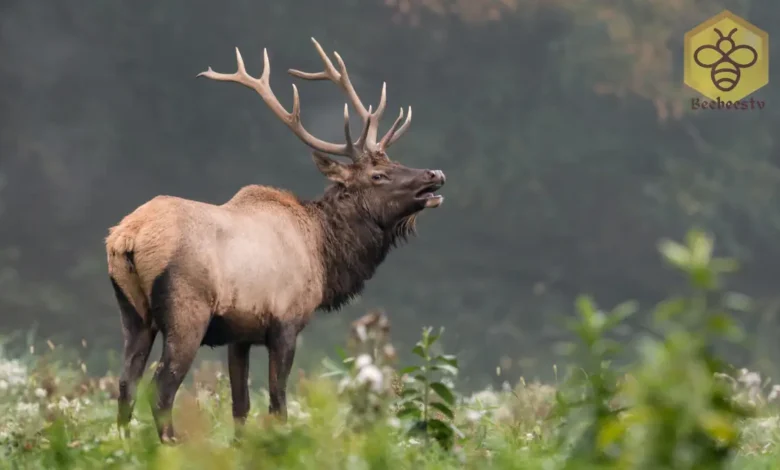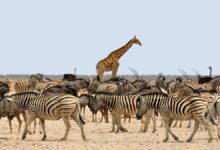Elk: Nature’s Powerful Giants

Elk: Classification, Characteristics, Habitat, Facts, and More…
Elk: Classification, Characteristics, Habitat, Facts, and More…
Introduction
The elk, one of North America’s most iconic large mammals, is renowned for its impressive antlers, majestic stature, and complex social behavior. This species, often spotted in forested regions and open meadows, has captivated the imagination of wildlife enthusiasts, hunters, and conservationists alike. Elk plays a crucial role in ecosystems and holds cultural significance for many indigenous groups.
Scientific Name
The elk’s scientific name is Cervus canadensis. The name reflects its North American roots, with “canadensis” referring to its historical abundance in Canada and other northern parts of the continent.
Common Name
While commonly known as elk in North America, in Europe, this same animal is referred to as the “wapiti.” It’s important not to confuse the North American elk with the European elk, which is a moose (Alces alces).
Scientific Classification
| Kingdom | Animalia |
| Phylum | Chordata |
| Class | Mammalia |
| Order | Artiodactyla |
| Family | Cervidae |
| Genus | Cervus |
| Species | Cervus canadensis |
Types of Elk
There are several subspecies of elk, each adapted to different environments across North America and Asia:
- Rocky Mountain Elk (Cervus canadensis nelsoni): Found primarily in the Rocky Mountain range, these are the most well-known and widely distributed subspecies in North America.
- Roosevelt Elk (Cervus canadensis roosevelti): The largest-bodied subspecies, found along the coastal regions of the Pacific Northwest.
- Tule Elk (Cervus canadensis nannodes): Native to California, these are the smallest of the elk subspecies.
- Manchurian Wapiti (Cervus canadensis xanthopygus): This Asian subspecies is found in the forests of China and Russia.
Habitat
Elk inhabit a variety of environments, including forests, meadows, grasslands, and alpine regions. They are highly adaptable, though they tend to prefer areas with a mix of open spaces for grazing and forested areas for cover. In the summer months, elk can be found at higher elevations, but as winter approaches, they migrate to lower elevations where food is more readily available. Their range includes North America, specifically the United States, Canada, and parts of Mexico, as well as Asia in regions like Siberia and Mongolia.
Physical Characteristics
Elk are among the largest members of the deer family, second only to the moose in size. Male elk, called bulls, can weigh up to 1,100 pounds (500 kg), while females, known as cows, are generally smaller, weighing around 500 to 600 pounds (225–275 kg).
- Antlers: Male elk grow large, branching antlers every year, which can reach up to 4 feet (1.2 meters) in length. These antlers are shed and regrown annually, primarily for use in attracting mates and in battles with other males during the breeding season.
- Color: Elk typically have a reddish-brown body with a lighter-colored rump. In the winter, their coat thickens and becomes darker.
- Height and Length: Elk stands about 4.5 to 5 feet (1.4–1.5 meters) at the shoulder, with a total body length of 8 feet (2.4 meters).
Diet
Elk are herbivores, and their diet varies depending on the season. In the spring and summer, elk consume grasses, sedges, forbs, and herbaceous plants. As winter approaches and these food sources become scarce, they switch to browsing woody vegetation such as shrubs, twigs, and bark. Their ability to digest a wide range of plant materials allows them to survive in diverse habitats.
- Spring/Summer: Grasses, herbs, wildflowers
- Fall/Winter: Woody plants, shrubs, tree bark
Predators and Threats
Though elk are large animals, they are not without natural predators. Wolves, mountain lions, and bears are their primary threats in North America. Calves are particularly vulnerable to predation. In addition to natural predators, elk face threats from human activities such as hunting, habitat destruction, and vehicle collisions.
- Natural Predators: Wolves, mountain lions, grizzly bears
- Human Threats: Habitat loss, hunting, vehicle collisions

Reproduction, Babies, and Lifespan
The elk breeding season, or “rut,” occurs in the fall, typically from late August to October. During this time, bulls will challenge each other for dominance and the right to mate with a harem of cows. The males will bugle—an eerie, high-pitched call—to attract females and intimidate rivals.
After a gestation period of approximately 240 to 262 days (about 8.5 months), female elk give birth to one, and occasionally two, calves in late May or early June. The calves are born with spotted coats, which provide camouflage from predators. They remain hidden in the vegetation for the first few weeks of life until they are strong enough to join the herd.
- Lifespan: In the wild, elk typically live 10 to 15 years, though some individuals can live up to 20 years.
Population
Elk populations are relatively stable, though their numbers have fluctuated historically due to habitat loss and overhunting. Conservation efforts in the 20th century helped to restore elk populations in many areas where they had been extirpated. Today, elk are found in healthy numbers across much of their historical range in North America, with an estimated population of over 1 million individuals.
Behavior and Lifestyle
Elk are social animals and often form large herds, especially during the winter when they gather for protection against predators. Their behavior changes throughout the year, largely in response to the breeding season and availability of food.
- Migration: Elk migrate seasonally, moving to higher elevations in the summer and descending to valleys in the winter to avoid deep snow and find food.
- Communication: Elk communicate through a variety of vocalizations, including the famous bugle call of the bulls during the rut, as well as barks and grunts.
Ecological Role
Elk play a crucial role in their ecosystems. As grazers, they help maintain healthy grasslands and prevent vegetation overgrowth. They are also important prey species for large carnivores, helping to support the populations of predators like wolves and bears.
FAQs
- What is the difference between an elk and a deer?
- Elk are much larger than deer, with males weighing up to 1,100 pounds compared to a deer’s 300 pounds. Elk also have larger antlers and a more complex social structure.
- Do elk migrate?
- Yes, they migrate seasonally, moving to higher elevations in the summer and lower elevations in the winter to find food.
- How long do elk live?
- They live 10 to 15 years in the wild, but some individuals can live up to 20 years under optimal conditions.
- What do elk eat?
- Elk are herbivores, and their diet consists of grasses, herbs, shrubs, and tree bark, depending on the season.
Conclusion
Elk are truly remarkable creatures, with their impressive antlers, complex social behaviors, and adaptability to diverse environments. As keystone species, they play an integral role in maintaining the health of ecosystems across North America and parts of Asia. Despite facing threats from predators and human activity, their populations remain stable, thanks in part to successful conservation efforts. By continuing to protect their habitat and ensure sustainable management practices, we can ensure that elk will thrive for generations to come.


